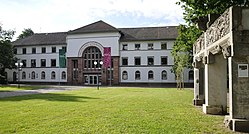
Frankfurt, officially Frankfurt am Main, is the most populous city in the German state of Hesse. Its 763,380 inhabitants as of 31 December 2019 make it the fifth-most populous city in Germany. Located on its namesake Main River, it forms a continuous conurbation with the neighboring city of Offenbach am Main and its urban area has a population of over 2.3 million. The city is the heart of the larger Rhine-Main metropolitan region, which has a population of more than 5.6 million and is Germany's second-largest metropolitan region after the Rhine-Ruhr region. Frankfurt's central business district, the Bankenviertel, lies about 90 km (56 mi) northwest of the geographic center of the EU at Gadheim, Lower Franconia. Like France and Franconia, the city is named after the Franks. Frankfurt is the largest city in the Rhine Franconian dialect area.
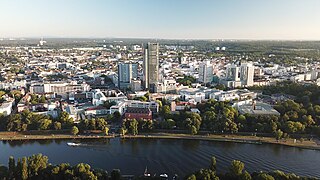
Offenbach am Main is a city in Hesse, Germany, on the left bank of the river Main. It borders Frankfurt and is part of the Frankfurt urban area and the larger Frankfurt Rhein-Main urban area. It has a population of 138,335.
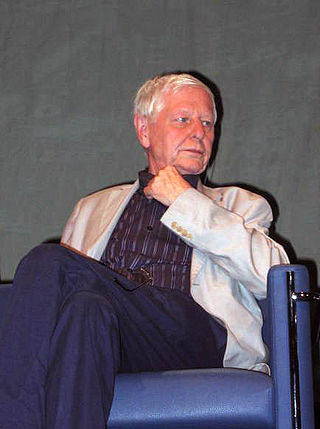
Hans Magnus Enzensberger was a German author, poet, translator, and editor. He also wrote under the pseudonyms Andreas Thalmayr, Elisabeth Ambras, Linda Quilt and Giorgio Pellizzi. Enzensberger was regarded as one of the literary founding figures of the Federal Republic of Germany and wrote more than 70 books, with works translated into 40 languages. He was one of the leading authors in Group 47, and influenced the 1968 West German student movement. He was awarded the Georg Büchner Prize and the Pour le Mérite, among many others.

Alfred Kerr was an influential German theatre critic and essayist of Jewish descent, nicknamed the Kulturpapst.

The Städel, officially the Städelsches Kunstinstitut und Städtische Galerie, is an art museum in Frankfurt, with one of the most important collections in Germany. The Städel Museum owns 3,100 paintings, 660 sculptures, more than 4,600 photographs and more than 100,000 drawings and prints. It has around 4,000 m2 of display and a library of 115,000 books.

The German Library in Frankfurt am Main (Deutsche Bibliothek abbreviated: DB) was a predecessor of the German National Library (DNB). From 1947 to 1990 it was the West German counterpart to the Deutsche Bücherei in Leipzig, founded in 1912, with the task of collecting German documents and publishing the national bibliography. After the reunification of Germany in 1990, the German Library and the German Library were merged to form "The German Library". Since 2006 it has been called the "German National Library". In 2006, around 8.3 million of the total holdings of the German National Library of 22.2 million units were stored in Frankfurt am Main. At the end of 2011, out of a total of around 27 million media copies, 10 million were archived in Frankfurt.
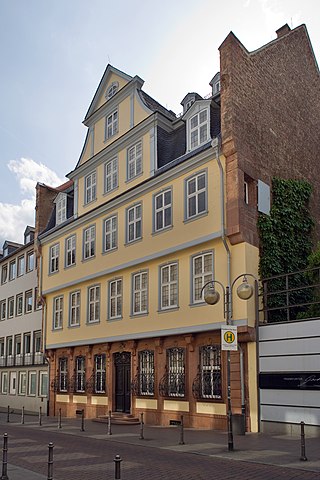
The Goethe House is a writer's house museum located in the Innenstadt district of Frankfurt, Germany. It is the birthplace and childhood home of German poet and playwright Johann Wolfgang von Goethe. It is also the place where Goethe wrote his famous works Götz von Berlichingen,The Sorrows of Young Werther, and the first drafts of Urfaust. The house has mostly been operated as a museum since its 1863 purchase by the Freies Deutsches Hochstift, displaying period furniture and paintings from Goethe's time in the house.
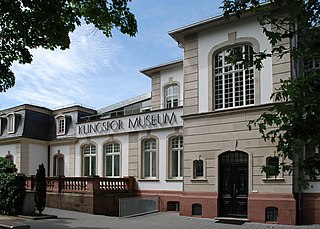
The Klingspor-Museum is a museum in Offenbach, Germany, specializing in the art of modern book production, typography and type. It includes a collection of fine art books from Karl Klingspor, one of the owners of Klingspor Type Foundry in Offenbach am Main, which inspired the museum's creation.

The Schirn Kunsthalle is a Kunsthalle in Frankfurt, Germany, located in the old city between the Römer and the Frankfurt Cathedral. The Schirn exhibits both modern and contemporary art. It is the main venue for temporary art exhibitions in Frankfurt. Exhibitions included retrospectives of Wassily Kandinsky, Marc Chagall, Alberto Giacometti, Bill Viola, and Yves Klein. The Kunsthalle opened in 1986 and is financially supported by the city and the state. Historically, the German term "Schirn" denotes an open-air stall for the sale of goods, and such stalls were located here until the 19th century. The area was destroyed in 1944 during the Second World War and was not redeveloped until the building of the Kunsthalle. As an exhibition venue, the Schirn enjoys national and international renown, which it has attained through independent productions, publications, and exhibition collaborations with museums such as the Centre Pompidou, the Tate Gallery, the Solomon R. Guggenheim Museum, the Hermitage Museum, or the Museum of Modern Art.
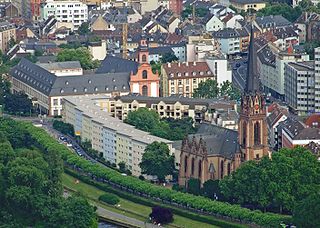
Museumsufer is the name of a landscape of museums in Frankfurt, Hesse, Germany, lined up on both banks of the river Main or in close vicinity. The centre is the historic art museum Städel. The other museums were added, partly by transforming historic villas, partly by building new museums, in the 1980s by cultural politician Hilmar Hoffmann. The exhibition hall Portikus was opened on an island at the Alte Brücke in 2006.
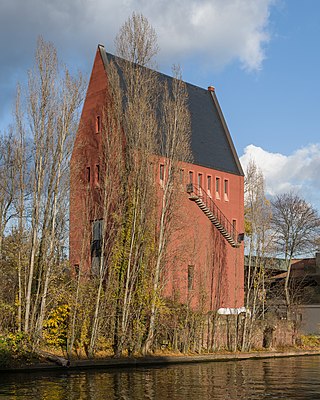
Portikus is an exhibition hall for contemporary art in Frankfurt am Main, that was founded in 1987 by Kasper König. The museum is part of the Museumsufer. Portikus presents the work of internationally renowned artists, and exhibits younger, emerging artists. Almost always, art work is commissioned for the gallery space.
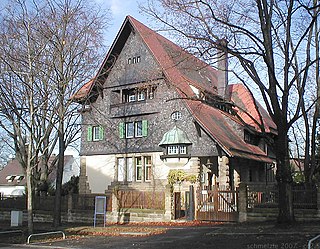
Hugo Eberhardt was a German Architect.

The Offenbach City Tunnel is a railway tunnel on the Frankfurt Schlachthof–Hanau line in Offenbach am Main in the German state of Hesse. It is used by all of the eastern branches of the Rhine-Main S-Bahn. It runs largely under Berliner Straße.

The Museum Giersch is an art gallery on the Main River in Frankfurt am Main, Germany, in the Museumsufer area.
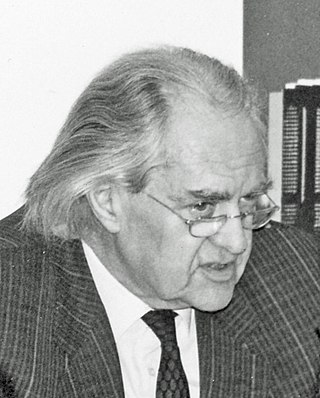
Hilmar Hoffmann was a German stage and film director, cultural politician and academic lecturer. He founded the International Short Film Festival Oberhausen. He was for decades an influential city councillor in Frankfurt, where he initiated the Museumsufer of 15 museums, including the Jewish Museum Frankfurt. He was the president of the Goethe-Institut and taught at universities such as Bochum and Tel Aviv. He wrote the book Kultur für alle, which was a motto of his life and work.

The Liebieghaus is a late 19th-century villa in Frankfurt, Germany. It contains a sculpture museum, the Städtische Galerie Liebieghaus, which is part of the Museumsufer on the Sachsenhausen bank of the River Main. Max Hollein was the director from January 2006 to 2016, followed by Philipp Demandt.
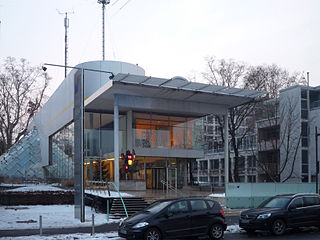
The Museum für Kommunikation is a museum of the history of communication in Frankfurt, Germany. It opened on 31 January 1958 under the name Bundespostmuseum and is the oldest museum on Frankfurt's Museumsufer.

The German Architecture Museum (DAM) is located on the Museumsufer in Frankfurt, Germany. Housed in an 18th-century building, the interior has been re-designed by Oswald Mathias Ungers in 1984 as a set of "elemental Platonic buildings within elemental Platonic buildings". It houses a permanent exhibition entitled "From Ancient Huts to Skyscrapers" which displays the history of architectural development in Germany.
Events in the year 1917 in Germany.

Iris Hanika is a German writer. She was born in Würzburg, grew up in Bad Königshofen and has lived in Berlin since 1979, where she studied Universal and Comparative Literature at the FU Berlin. She was a regular contributor to German periodicals like Frankfurter Allgemeine Zeitung and Merkur. Hanika won the LiteraTour Nord prize and the EU Prize for Literature for her novel Das Eigentliche. In 2020, she was awarded the Hermann-Hesse-Literaturpreis for her novel Echos Kammern. In 2021, she won the Leipzig Book Fair Prize. Hanika wrote previously mainly short non-fictional texts, later novels, including two books on psychoanalysis.
